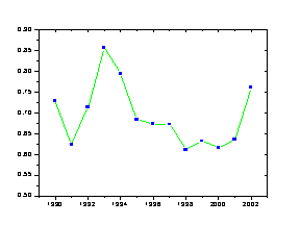(Clearwisdom.net) Recently, astronomers have observed many amazing astronomical phenomena, for instance, the formation of novae and the collision of galaxies. The ancient Chinese people considered that human affairs could be predicted through celestial observations.
The spreading of Falun Dafa is an extremely important occasion in human history, which must be reflected via celestial phenomena. In fact, during the 10 years of Falun Dafa's introduction to the public, scientists have observed numerous intriguing celestial changes. Because the data of some of the observations are relatively scattered and are also affected by the development of technology, it is very hard to give statistics of the changes. But as the observations of supernovae have been recorded and observed for quite a long period of time, and the data that has been recorded is sufficient and the technology used to record supernovae is also relatively stable, we can therefore provide a statistical analysis of the supernovae.
A supernovae refers to the phenomenon of a star exploding, which in turn generates a great amount of energy in a short period of time. The supernova "1987A," which was discovered in 1987, is a typical example. When the supernova occurred, in just a few hours the brightness increased to the degree that enabled it to be visible by the human eye and it lasted for a few months before it dimmed down.
1. Data Source
All data used in this report was taken from: http://cfa-www.harvard.edu/cfa/ps/lists/Supernovae.html (The Central Bureau for Astronomical Telegrams (CBAT) operating at the Smithsonian Astrophysical Observatory.) This website lists all of the supernovae discovered from 1006 up to today.
2. Is it because research equipment has improved or is it because there have been celestial changes?
The magnitude of each of the supernovae at discovery is also listed in the above website. The smaller the magnitude is, the stronger the intensity is indicated. As the observing technology and instruments are becoming more and more accurate, more and more phenomena are discovered. In order to avoid the influence from the instruments' increasing accuracy, we chose a magnitude of 20 as the reference point because the technology in 1950 was already capable of detecting this level of supernova. For instance, previously, one was only able to detect supernovae with a magnitude equal to or less than 18, thus 100 percent of the discoveries made were of supernovae with intensities higher than 18. When apparatuses that were able to detect supernovae with a magnitude of 20 became available, one was able to observe supernovae with intensities weaker than magnitude 18, thus the percentage of the discoveries made of supernovae with intensities stronger than magnitude 18 would be reduced and therefore the average intensity would be accordingly reduced. In other words, if the observed supernovae with intensity stronger than magnitude 20 are influenced by the apparatus' sensitivity, the corresponding ratio of the supernova with intensity stronger than magnitude 18 would be reduced yearly with the increasing sensitivity of the apparatus. The average intensity of the supernovae with a magnitude of less than or equal to 20 would also decrease yearly. Figure 1 plots the percentage of the supernovae discovered recently with intensities stronger than magnitude 18 among all supernovae whose intensities are greater than or equal to magnitude 20 as a function of time. It can be seen that after 1990, there are both increases and decreases in the ratio of the strong supernovae. In figure 2, we plotted the average magnitude of supernovae with less than 20 as a function of time starting from 1990. We can see that there are also increases and decreases in this average magnitude and that the corresponding changes are within the standard deviation. This way, the possible influence from the apparatus' sensitivity on the discovery of supernovae with intensity equal to or stronger than magnitude 20 is removed.
3. Figure 3 shows the number of supernovae discovered since 1980 with magnitude less than 20. From Figure 3, one can see that the number of the supernovae reached a peak in 1992. In 1999, the number reached a new peak and stayed at the same level in 2000. (The low value of that of 2002 is due to the incomplete data for only five months.) It is well known that Falun Dafa was first introduced to the public in 1992 and has been persecuted in China since 1999. Could this be just a coincidence?
Figure 3. The number of supernovae with a magnitude of less than 20 since 1980Although these supernovae are very far away from our earth, this didn't stop people in ancient China from viewing them as they held the saying: "viewing the celestial phenomena in the night." The ancient people not only watched the celestial phenomena within the solar system, but also those very remote stars. The ancient people were able to predict big occurrences that would happen within a few days or in a few months through observing the celestial climate manifested by the remote stars. Examples of this can be found everywhere in Chinese historical literature. We know that the nearest star outside the solar system is as far as a few light years from our earth. The celestial phenomena are related to what is happening on earth. Although the relationship is far beyond the knowledge of modern science, it was recognized by the ancient Chinese people, "Because ancient Chinese science focused directly on the human body, life, and the universe, and it studied these subjects directly, it took a different approach." (Zhuan Falun --- Lecture Seven) When the cosmos is undertaking a gigantic change, there will be corresponding reflections in both the human world and celestial phenomena. This kind of "coincidence" is not at all surprising.
References:
1. http://cfa-www.harvard.edu/cfa/ps/lists/Supernovae.html.
2. http://cfa-www.harvard.edu/iau/cbat.html.
Category: Perspective











